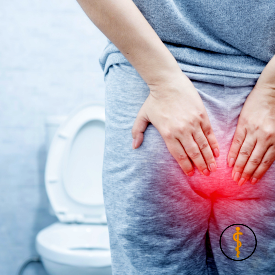Laser/Stapler Piles Treatment

Piles, also known as hemorrhoids, are swollen veins in the anus and lower rectum. They can be either internal (inside the rectum) or external (around the anus opening). Piles can affect people of all ages, though individuals between 50 and 60 are more prone to experiencing them.
While piles are generally not considered a serious condition, they can cause discomfort and may require treatment. In mild cases, lifestyle changes such as a high-fiber diet, good hydration, and over-the-counter remedies can help. However, more severe cases may require surgical intervention.
| Features | Open Surgery | Laser Surgery |
|---|---|---|
| Cuts | Multiple | Minimal |
| Scars & Stitches | Multiple | Minimal |
| Pain Level | Painful | Minimal Pain |
| Blood Loss | High | Low |
| Infection Risk | High | Minimal |
| Recovery Time | Bed Rest | Fast Recovery |
| Hospital Stay | Long | Short |
| Technology | Outdated | Advanced |
Internal piles form inside the rectum and are classified into different grades:
External piles develop around the opening of the anus and may cause pain, itching, and discomfort. These can often be managed with conservative treatments like sitz baths and topical ointments. However, surgery may be necessary if they become thrombosed or cause severe symptoms.
Common symptoms include:
If you’re experiencing these symptoms, consult with a specialist to determine the best treatment plan.
Piles are diagnosed through a combination of medical history, physical examination, and diagnostic tests:
If you’re dealing with piles, consult Dr. Mohit Agrawal for expert diagnosis and personalized treatment. As a specialist in laser and stapler piles surgery, Dr. Agrawal uses advanced, minimally invasive techniques to ensure effective relief with minimal pain and quick recovery. Whether you need lifestyle changes or surgical intervention, Dr. Agrawal tailors the treatment to your specific condition, helping you recover swiftly and comfortably.
Laser piles treatment is a minimally invasive procedure that uses a laser beam to shrink and seal off hemorrhoids (piles). It is quick, precise, and involves minimal bleeding, making it a popular treatment option.
Stapler piles surgery, also known as stapled hemorrhoidopexy, is a procedure that removes or repositions prolapsed hemorrhoidal tissue using a surgical stapler. It reduces pain and speeds up recovery compared to traditional surgeries.
These treatments are suitable for patients with moderate to severe hemorrhoids, especially those experiencing symptoms like pain, bleeding, prolapse, or difficulty with bowel movements. A consultation with a specialist is necessary to determine the best option for your condition.
Laser piles treatment offers several benefits, including:
1) Minimal pain and bleeding
2) Faster recovery time
3) No cuts or stitches
4) Reduced risk of recurrence
5) Performed as a day-care procedure
Advantages include:
1) Less postoperative pain compared to traditional surgery
2) Faster recovery
3) Effective for treating prolapsed hemorrhoids
4) Minimal scarring and tissue damage
A focused laser beam is used to shrink hemorrhoids by coagulating blood vessels and sealing the affected tissue. The procedure is precise and minimizes damage to surrounding tissue.
A circular stapling device is used to remove excess hemorrhoidal tissue and reposition the remaining tissue back into its normal position. The stapler also seals the blood supply to hemorrhoids, reducing their size and symptoms.
Both laser and stapler piles procedures usually take 20-40 minutes, depending on the severity of the condition.
Recovery is quick for both procedures. Most patients can resume normal activities within 2-3 days and fully recover in 1-2 weeks.
Both laser and stapler piles treatments are minimally painful compared to traditional surgery. Any discomfort is usually mild and can be managed with medications.
While rare, possible risks include:
1) Mild bleeding
2) Infection
3) Recurrence of hemorrhoids
4) Temporary discomfort in the treated area
Yes, most health insurance policies cover these procedures if they are medically necessary. Check with your insurance provider for specific coverage details.
The cost of laser piles treatment typically ranges between ₹40,000 and ₹80,000, while stapler piles surgery ranges between ₹50,000 and ₹1,20,000. The cost varies based on the hospital, surgeon, and severity of the condition.
Laser piles treatment is usually a daycare procedure, so you can go home the same day. Stapler piles surgery may require a hospital stay of 1-2 days.
Mumbai offers access to experienced proctologists, state-of-the-art medical facilities, and advanced technology for minimally invasive treatments. Patients can expect world-class care at affordable prices.
Preparation may include:
1) Completing blood tests or imaging studies as prescribed by your doctor
2) Fasting for a few hours before the procedure
3) Avoiding certain medications like blood thinners before surgery
Ready to take the next step towards expert and personalized care for Laser/Stapler Piles Treatment?
Contact us today to schedule your consultation. Our experienced Laser/Stapler Piles Treatment team is here to provide expert guidance and ensure your comfort throughout the process.